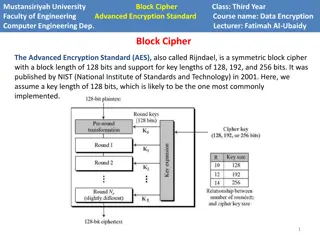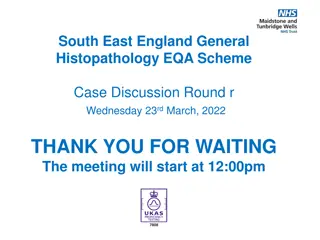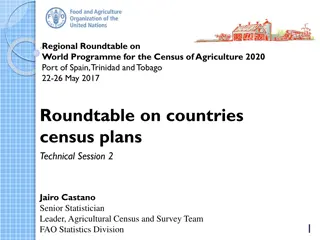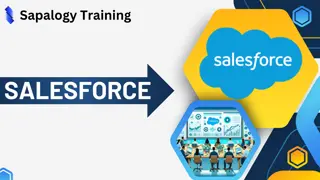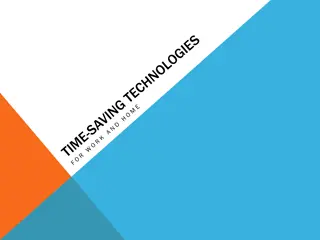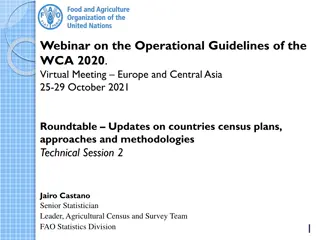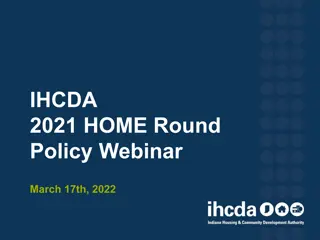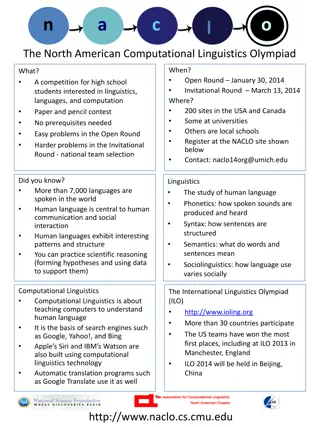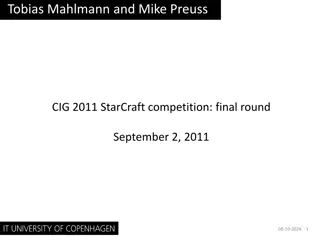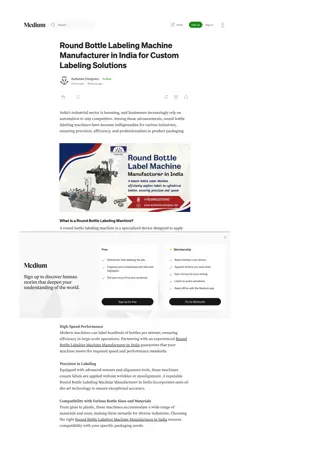
Illinois Job Training and Economic Development Grant Program Round 2 Overview
Explore the Illinois Job Training and Economic Development Grant Program Round 2, focusing on program design, services, goals, and outcomes. Learn about the guiding legislation, program priorities, eligible entities, targeted industries, and more. Discover how this program aims to address economic demands and support businesses and individuals in Illinois.
Download Presentation

Please find below an Image/Link to download the presentation.
The content on the website is provided AS IS for your information and personal use only. It may not be sold, licensed, or shared on other websites without obtaining consent from the author. If you encounter any issues during the download, it is possible that the publisher has removed the file from their server.
You are allowed to download the files provided on this website for personal or commercial use, subject to the condition that they are used lawfully. All files are the property of their respective owners.
The content on the website is provided AS IS for your information and personal use only. It may not be sold, licensed, or shared on other websites without obtaining consent from the author.
E N D
Presentation Transcript
Illinois Job Training and Economic Development Grant Program Round 2 Notice of Funding Opportunity Review Illinois Department of Commerce and Economic Opportunity
Agenda Agenda JTED Round 2 Program Overview Program Design Program Services Perforance Goals and Outcomes Application Components Capacity Need Program Plan Budget Submission and Review Criteria 2
Guiding Legislation and Highlights Guiding Legislation and Highlights Illinois Legislation Job Training and Economic Development Act 20 ILCS 605/605-415 (JTED Act) 56 Ill. Admin. Code Part 2660 (JTED Rules) Highlights Focus on low-income communities defined Qualified Census Tract Disproportionately impacted areas Highlights Target industries and occupations struggling in aftermath of the pandemic to find workers Growth sectors Small businesses (250 or fewer) Funding two categories Adult Youth Target Populations Unemployed, Under-employed and Under-represented populations Includes barrier reduction funding for emergency costs Priority Populations Migrants, immigrants, and refugees Justice-involved individuals Rural residents Period of Performance May 1, 2024, and ends on April 30, 2026 (2 years) NOFO Page 1 3
JTED Program JTED Program Job Training and Economic Development (JTED) Spring 2021 updated the original JTED Act Reinvents the program to meet current economic demands. Responsive to Illinois businesses and individuals needs Eligible Entities Program Priorities Targeted Industries $35 Million in JTED Funds $20m was released in the first round of JTED to 44 grantees $13-$15 million to be released May 2024 Anticipated minimum number served 1,000 Cost per participant range $2500 (original JTED) up to $20,000 based on program design and identified barriers of those served $250 - $750k award range 30 anticipated awardees Program Elements Program Categories Targeted Populations Targeted Communities 4 NOFO Page 1-2
Eligible Entities Eligible Entities Eligible Entities Those organizations that demonstrate expertise and effectiveness in administering workforce development programs and includes: Private nonprofit organizations (including faith-based organization) Federal Workforce Innovation and Opportunity Act (WIOA) administrative entities Community Action Agencies Public or private educational institutions Industry associations Employers Program Priorities Targeted Industries Program Elements Program Categories Targeted Populations Targeted Communities NOFO Page 2 5
Target Industries Target Industries Industries must be struggling with identifying skilled works in the aftermath of the pandemic, or be in a growth sector identified by the local LWIA workforce development plan, or be a small business (250 or fewer employees) Eligible Entities Program Priorities Targeted Industries Program Elements Strong career clusters identified in the governor s 5-year economic plan that should be considered Manufacturing, Agriculture, Food and Natural Resources (Energy), Information Technology, Transportation, Distribution and Logistics, Architecture and Construction, Health Science, Hospitality and Tourism. Program Categories Targeted Populations Targeted Communities NOFO Page 2 6
Target Communities Target Communities Qualified Census Tract (QCT) a census tract, as defined by the U.S. Census Bureau, having 50 percent of households with incomes below 60 percent of the Area Median Gross Income (AMGI) or having a poverty rate of 25 percent or more. Eligible Entities Disproportionately Impacted Areas (DIA) those ZIP Codes most severely affected by the COVID-19 pandemic, to be determined based on positive COVID-19 case per capita rates, and high rates in at least one of the following poverty-related categories relative to other ZIP Codes within their region and share of population consisting of: children aged 6 to 17 in households with income less than 125% of the federal poverty level (FPL); adults over age 64 in households with income less than 200% FPL; household with income less than 150% FPL; and children ages 5 and under in households with income less than 185% FPL. This link provides a map of the Qualified Census Tracts and Disproportionately Impacted Areas: https://www.illinoisworknet.com/qctdiamap Program Priorities Targeted Industries Program Elements Program Categories Targeted Populations Targeted Communities 7 NOFO Page 4
Target Populations Target Populations Unemployed Individual who is without a job who wants and is available for work. Under-employed Individual who is employed and needs job training to address the negative economic or public health impacts experienced by the COVID-19 pandemic due to the individual's occupation or level of training. Eligible Entities Program Priorities Targeted Industries Under-represented - Individual who resides in or receive services in a qualified census tract, disproportionately impacted area or who has experienced negative economic or public health impacts resulting from the COVID-19 pandemic. Includes youth who have one or more barriers to employment identified as risk factors. Includes individuals who are long-term unemployed. Program Elements Program Categories Target Populations Targeted Communities 8 NOFO Page 2-4
JTED Program Categories JTED Program Categories Eligible Entities o Category 1 Adult Focus o providing services to unemployed, under-employed or under-represented adults who need the training to access employment or skill upgrades to advance in their employment. Adults must be 18 years or older who reside in and are eligible to work in Illinois Program Priorities Targeted Industries Program Elements o Category 2 Youth Focus o Offers career development opportunities and work- based learning (e.g., pre-apprentice and apprenticeship) for youth ages 16-24 with one or more barriers to education, training, and employment. Program Categories Targeted Populations Targeted Communities 9 NOFO Page 4-7
JTED Program Priorities JTED Program Priorities o Immigrants and Refugees o more than one-third of physicians and surgeons are immigrants, and about 43 percent of metal and plastic workers are immigrants o Illinois immigrants have $51 billion in spending power and make $20 billion in tax payments o Rural Residents o about 1.4 million Illinois residents live in rural counties. o applicants must serve rural and nonmetropolitan areas, including 62 Illinois counties, based on the proportionate share of the population: https://www.ers.usda.gov/data- products/rural-urban-continuum-codes/ o Justice-involved Individuals o there are currently 17,831 persons on parole in Illinois. This includes 3,584 convicted for drug crimes and 2,735 for property crimes o applications will demonstrate active relationships with second- chance employers, a process to work with parole officers if applicable, and collaboration with organizations with expertise in legal services, counseling, housing services, etc. Eligible Entities Program Priorities Targeted Industries Program Elements Targeted Communities Targeted Populations Targeted Communities 10 NOFO Page 4-7
JTED Program Services JTED Program Services JTED program services address the economic impacts experienced by employers and individuals that are underemployed, unemployed or facing other employment barriers by providing employment and training services aligned with a career pathway that supports targeted industries Training /Sector Based/Employability Skills Outreach and Recruitment Employer Engagement Career Planning Work-Based Learning / Work-Based Training Supportive Services / Barrier Reduction Funds Placement Follow-Up 11 NOFO Page 7-13
Outreach and Recruitment Outreach and Recruitment & Employment Engagement & Employment Engagement Applicants must include an outreach and recruitment strategy for how they will enroll participants. Outreach and recruitment through established and expanded partners, employer/industry organizations, social service agencies, and others. Employer Engagement - employers should have a leadership role in developing and supporting the career pathway programs that integrate work-based learning opportunities through experience. Competitive projects will provide evidence of business commitment and demonstrate the strategies that will be used to engage area employers. Outreach and Recruitment Employer Engagement Career Planning Training Work-Based Learning / Work-Based Training Supportive Services / Barrier Reduction Funds Placement Follow-Up 12 NOFO Page 7-8
Career Planning Career Planning Successful career planning is a collaborative and ongoing process. A thorough assessment is the foundation for understanding the participant s employment goals, existing skills, career readiness and determining all barriers to employment that may exist. Each participant needs an Individual Employment Plan (IEP) which is living document that identifies employment and education goals as part of a career pathway, objectives, and the appropriate combination of services for the participant to reach the goals. Outreach and Recruitment Employer Engagement Career Planning Training Work-Based Learning / Work-Based Training Supportive Services / Barrier Reduction Funds Placement Follow-Up 13 NOFO Page 8-10
Training Training Programs must lead to industry-recognized or post-secondary credentials and align with the customer's choice for a career pathway. Occupational skills training, training for nontraditional employment Skill upgrading and retraining Entrepreneurial training Job readiness training Adult education and literacy activities Training /Sector Based/Employability Skills Outreach and Recruitment Employer Engagement Career Planning Work-Based Learning / Work-Based Training Supportive Services / Barrier Reduction Funds Placement Follow-Up 14 NOFO Page 10-11
Work Work- -Based Learning Based Learning Work-based learning provides more opportunities for workers to earn income while gaining critical job skills. The following work-based learning services are allowed under this grant: Apprenticeship (pre-apprenticeship) On the Job Training (OJT) Incumbent Worker (IW) Training Customized Training Work Experiences or Internships Transitional Jobs (Adult only) Outreach and Recruitment Employer Engagement Career Planning Training Work-Based Learning / Work-Based Training Supportive Services / Barrier Reduction Funds Placement Follow-Up 15 NOFO Page 11-12
Supportive Services & Barrier Reduction Supportive Services & Barrier Reduction Supportive Services provide participants with key assistance beyond career and training services necessary for the participant to engage in the program Barrier Reduction is funding to increase family stability and job retention by covering accumulated emergency costs for basic needs. Outreach and Recruitment Employer Engagement Career Planning Training Work-Based Learning / Work-Based Training Supportive Services / Barrier Reduction Funds Placement Follow-Up 16 NOFO Page 12
Placement & Follow Placement & Follow- -Up Up Place participants in family sustaining unsubsidized employment. Follow-up services after training completion is encouraged, as appropriate, for adult and youth participants in workforce activities who are placed in unsubsidized employment. Outreach and Recruitment Employer Engagement Career Planning Training Work-Based Learning / Supportive Services / Barrier Reduction Funds Placement Follow-Up Work-Based Training 17 NOFO Page 12-13
JTED Performance JTED Performance Performance Goals Performance goals must be established for each training program. Performance Standards Acceptable performance for the above measure is set at 75% of the planned goal. Outcome Metrics JTED program will keep track of outcomes utilizing the Illinois workNet system. These metrics will inform the Department of the efficiency and effectiveness of employment and training services provided under this NOFO Performance Reports The Department requires reporting on targeted communities, target population characteristics, service, matching funds, and outcomes; collected by grantees and available through Illinois workNet system. NOFO Page 14
JTED Performance Goals JTED Performance Goals Performance Goals Applicants are required to establish performance goals. Number of individuals enrolled in the program Number of individuals completing the program Number of individuals obtaining credential(s) Number of individuals that achieve a measurable skill gain Number of individuals placed in post-secondary education Number of individuals placed in unsubsidized employment Number of individuals retained in unsubsidized employment for 6 and 12 months Number of individuals experiencing a wage/benefit increase (Incumbent worker) NOFO Page 14
JTED Outcome Metrics Performance Metrics Performance metrics includes (but not limited to the following): Number of businesses engaged Number of individuals placed and number acquiring an Industry-Linked Credential, Certification, or License Number of individuals placed and number completing a Pre- Apprenticeship, Registered Apprenticeship, or a Non-Registered Apprenticeship Program Number of individuals placed and number completing an OJT Number of individuals placed and number completing a paid work experience or internship Number of individuals continuing a Pre-Apprenticeship, Registered Apprenticeship, or a Non-Registered Apprenticeship Program at case closure Number of individuals achieving digital competency Number of individuals employed in the sector Number of individuals promoted in the sector 20 NOFO Page 14-15
Application Components Application Components Budget Narrative, Cost Effectiveness, Return on Investment, Sustainability Application Organization Capacity Documentation of Need Program Plan Program Goals 21 NOFO Page19-21
Application Organization Capacity Application Organization Capacity Applicants' history, partners and staff capacity Capacity to run a successful training program and complete within the timeframe Relationships with business in the targeted industries Experience in working with the target/priority population Expertise in working with training providers/partners Application Organization Capacity 22 NOFO Page 19-20
Documentation of Need Documentation of Need Identify where the project will recruit customers and provide services. Based on LMI what targeted industry(s) and occupations and career pathway will be the focus Need for quality training in sector and leveraged resources Impact of program on stabilizing employers Identify the need of the target/priority population(s) to be served Documentation of Need 23 NOFO Page 20
Program Plan Program Plan Applicants can include one or more sector training programs under one application. Focus on equity Outreach and recruitment of target/priority population Culturally relevant content on career offerings Employer needs and participation Process to serve individuals Partner collaborate on service delivery to maximize benefits Program Plan 24 NOFO Page 20
Program Plan Program Plan Quality of training providers and credentials Support services and barrier reduction delivery Process for placement in employment or post secondary education Coordination with partners programs on referrals Program assessments Program implementation timeline and training program summary Program Plan 25 NOFO Page 20
Budget Narrative, Cost Effectiveness, Return on Budget Narrative, Cost Effectiveness, Return on Investment, and Sustainability Investment, and Sustainability Justification of budget and analysis of the cost efficiency in relationship to planned outcomes Detailed narrative of each line items costs needs to be included in the budget template Leveraged and matching funds (is not required but should be included to show the full picture of what funding sources are paying for what services ) Subcontract funded under the grant Budget Narrative, Cost Effectiveness, Return on Investment, Sustainability Services provided through leveraged resources 26 NOFO Page 21
Performance Goals Performance Goals Performance Goals indicate goals for each training programs. Number of individuals enrolled in the program Number of individuals completing the program Number of individuals obtaining credential(s) Number of individuals that achieve a measurable skill gain Number of individuals placed in post-secondary education Number of individuals placed in unsubsidized employment Number of individuals retained in unsubsidized employment for 6 and 12 months Number of individuals experiencing a wage/benefit increase Performance Standard: Acceptable performance for the above measures is set at 75% of the planned goal. Additional Metrics will be evaluated for efficiency and effectiveness of employment and training services. Program Goals 27 NOFO Page 21
Documents for Submission Documents for Submission Standard Application Package: DCEO Uniform Grant Application Uniform Budget Template Conflict of Interest Disclosure Form Mandatory Disclosure Form Programmatic Specific Items: JTED Program Application Memorandum of Understanding (MOU) or Partnership Agreements (as applicable) 28 NOFO Page 21-22
Review Criteria Applicant Capacity (25%) Documentation of Need (15.5%) Quality of Program Plan (44%) Budget Narrative, Cost Effectiveness, Return on Investment, Sustainability (15.5%) 29
Submission Application Deadline: The application due date for this round of funding is 5:00PM CST January 10, 2024 Grant application forms are available at this link JTED NOTICE OF FUNDING OPPORTUNITY 2023 30 NOFO Page 23




